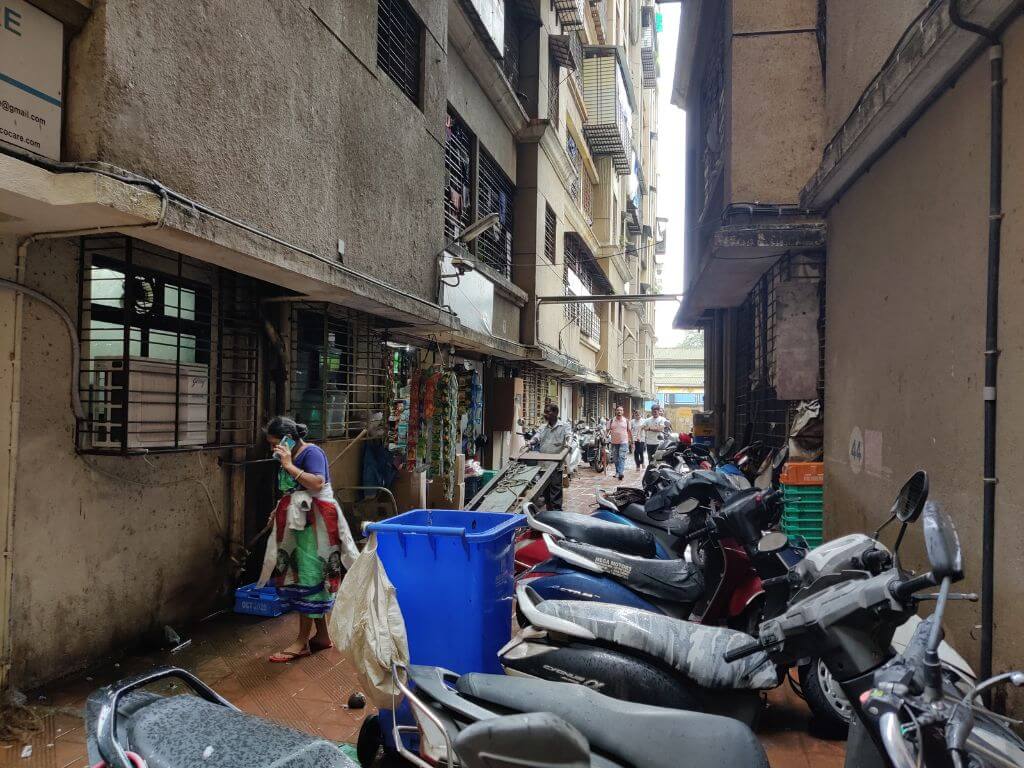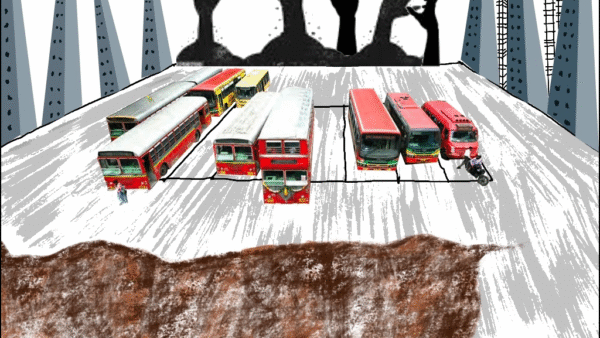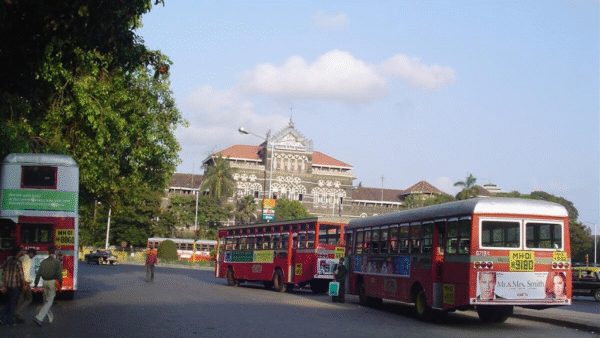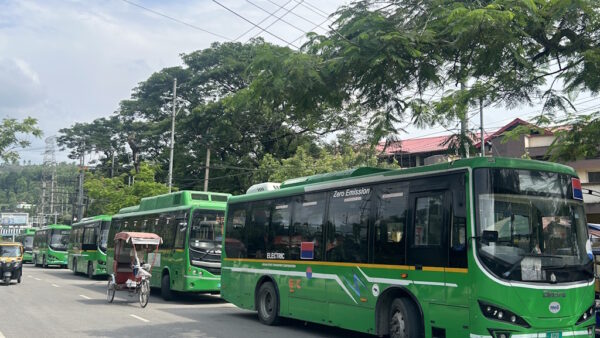Nestled behind the tall and gleaming Sunshine Tower on Tulsi Pipe Road between Dadar and Prabhadevi stations in Mumbai are buildings that draw less attention, if at all. These are mid-rises, standing closer to each other than the towers, their facades worn out and crumbling, somewhat of an oddity amidst the glitz and elegance of their taller neighbour. In these smaller buildings, live the 500 families of the Shroffwadi slum that used to be on this land.
The land was redeveloped in 2006 and slum dwellers ‘rehabilitated’ in the densely situated buildings eloquently named Swarajya Cooperative Housing Society. However, except for sanitation facilities in their houses, living conditions are not substantially better than in the slum, they say. On the ground and lower floors, sunlight and fresh air rarely reach, common open spaces are virtually non-existent pushing families into cramped tenements of 225 to 300 square feet, and the buildings are apart by barely three-four metres. Residents are forced to keep lights on throughout the day, litter is strewn in corridors, water flows down the staircase in the monsoon carrying filth with it. Ruby Fernandez, 25, lives with her family of five and a pet dog in a ground-floor tenement: “I still feel like we live in a chawl, not an apartment building. Everybody treats it like a chawl.”.
Constructing Swarajya society to rehabilitate slum dwellers was incidental; the purpose of redeveloping Shroffwadi was to construct Sunshine Tower with carefully planned apartments to receive sunlight and fresh air, tiled pathway leading to the tower, relatively large open spaces for its upmarket residents, uniformed security at the gates and entrances, entryway for cars to reach the main road which, ironically, becomes the playground for children of the ‘lesser’ building. The difference between the Sunshine Tower and Swarajya buildings could not be starker. This is but one of the many thousands of Slum Rehabilitation Authority (SRA) buildings across Mumbai, this pattern repeats itself in almost every SRA building.
Dr Babasaheb Ambedkar Nagar SRA building shares a compound wall with Swarajya society. Less than a stone’s throw away is a multi-tower commercial complex with offices of many of India’s top-lined corporates, banks, and media firms. The conditions in this SRA are like those in Swarajya society, not the towers. Shashikant Kamble, 64, living here for 14 years since his slum was demolished to make way for the commercial complex, said, “Fire engines wouldn’t be able to enter our lane if a fire breaks out.”
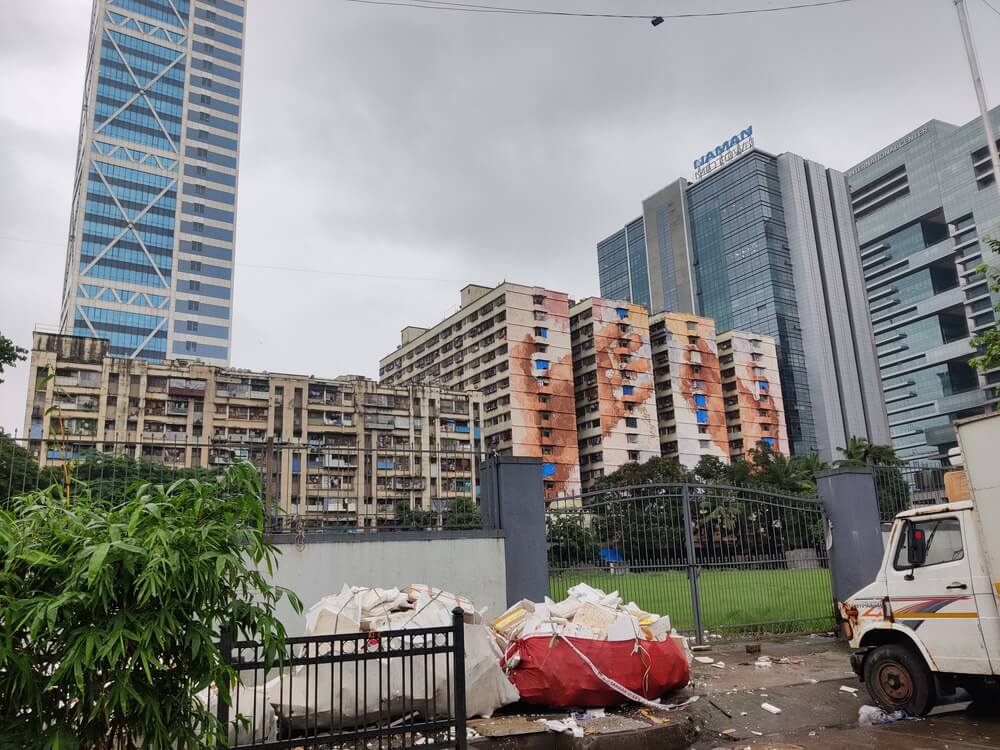
In Golibar, Santacruz, besides the lack of open spaces and congested spacing, residents also complain of the sewage network being of such poor quality that their toilets do not drain out properly, causing health hazards. In some redeveloped buildings, mockingly called ‘slumscrapers’, elevators do not work and common areas are not maintained because residents do not have money for maintenance. The worst flats are the ones on ground and first floors at the back of every building here. “Even if we keep the tubelight on throughout the day, we cannot see. Maybe a jail is like this,” said Meherunissa, cradling her grandson in her arms. “His parents don’t want him to grow up here.”
Colossal failure
The SRA-fication of Mumbai began in 1997, two years after the Slum Rehabilitation Authority was set up with the promise of rehabilitating four million slum dwellers with free houses which were to be built by private builders in return for developing the rest of the slum land. This free-sale component with higher Floor Space Index was the lure for private builders and real estate firms; they could trade in Transfer of Development Rights (TDR) across the city too, thus securing a win-win.
In the bargain, the buildings they constructed to “rehabilitate” slum dwellers came low on their priority – substandard materials were used, open spaces were not provided, the buildings spaced close so that maximum area of the plot could be freed for the commercial component. Almost all SRA buildings have residents complaining of issues that Fernandez, Kamble and Meherunissa spoke about.
In fact, studies show that there has been an increase in health issues, especially tuberculosis which is one of the health fallouts of inferior spatial design which restricts the movement of fresh air. The uncleaned water tanks and litter all around has made other illnesses such as gastroenteritis common in these buildings. With no open space, children are forced indoors. How is this an improved quality of life for slum dwellers?
Besides this, the performance has been so poor that only about two lakh slum dwellers, of the four million or 40 lakh, have houses in these buildings, according to the review by former chief minister Uddhav Thackeray three years ago. This means barely 9,000 people from slums were “rehabilitated” every year; going by the SRA’s figures of 12.5 lakh slums with more than six million people, it would take decades to rehouse them all.[1]
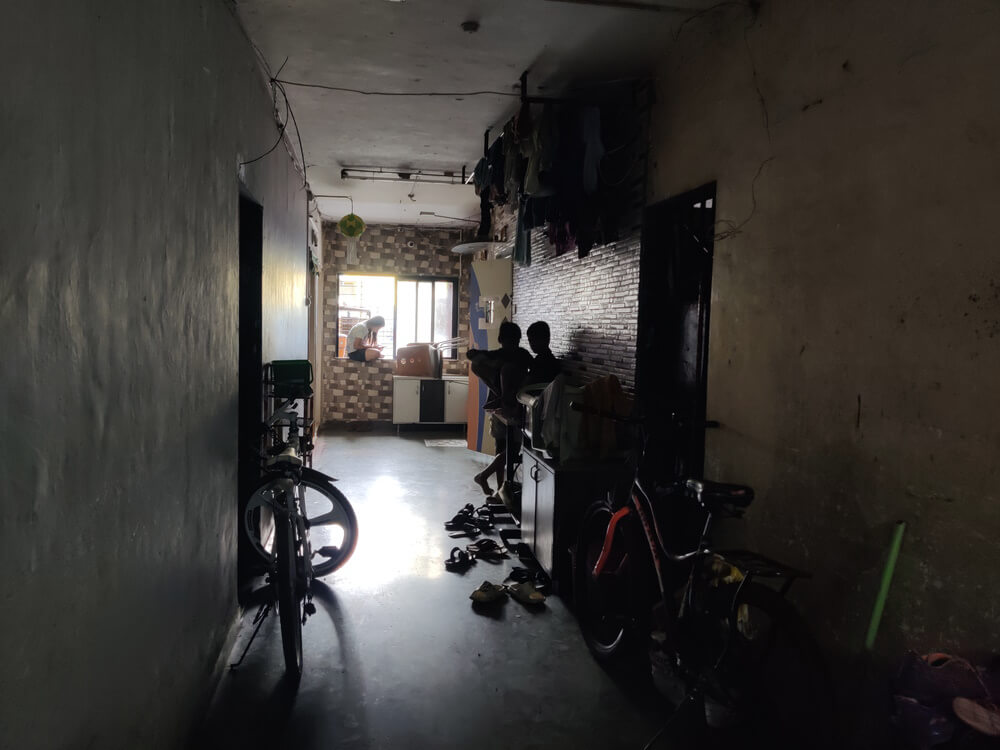
The SRA model aimed to use land as a monetisable resource. While it provided for the in-situ rehabilitation of the eligible slum dwellers by giving one tenement per family on the redeveloped land, the builders focused on commercially exploiting the rest of the slum land. The eligibility for a house in the redeveloped buildings depended on residents’ ability to prove, with documents, that they had been living in the slum prior to the cut-off date which was changed from January 1985 to January 1995 and later to January 2000.
Where would the rest go? Neither the SRA nor the government had any answers. This meant that every SRA project left a few families homeless in its wake, who set up slums elsewhere. Often, residents who were allotted houses also gave them on rent or sold them off after the cooling period to resettle in another slum.
In Thackeray’s review, it was found that while 2,131 SRA projects were underway, another 500 had been stuck at various stages of the process since 2005. These ‘dead’ projects had affected nearly a lakh of slum dwellers, but what was the most telling comment on the SRA model was that the maximum number of these projects were in areas that had the largest number of slums and counted among the poorer areas of Mumbai.[2]
In both qualitative and quantitative terms, the SRA model has been a colossal failure, falling short of its aims. It provided neither an adequate number of houses nor reasonable quality housing. Observing that a “slum” in Mumbai is now experienced as a deliberate strategy, Dr Amita Bhide, Professor of Habitat Studies at the Centre for Urban Policy and Governance, Tata Institute of Social Sciences (TISS) in her research paper ‘Colonising the Slum’ called it “a site of application of power by which the state generates opportunities for the real estate market in the name of ‘rehabilitation of the urban poor’ and creates formal-looking settlements with little consideration for conditions of life in them.”[3]
An illustrative case is Worli’s Maya Nagar, a slum rehabilitation project that began in 1994 is yet to give houses to 70 of 270 families. Sandeep Kharat was in Class 4 when talks of redevelopment began; his child is in Class 4 now and the project may take two more years. A managing committee member, Kharat believes that the delay is on part of the developer. The first building, he said, was completed in 2006 and the second in 2016.
Maya Nagar falls under the Coastal Regulation Zone which has an FSI of 1.33. “This meant that the developer would have less saleable area, he fought to not have the CRZ restrictions…The delays are to make as much money as possible through the increasing land values,” said Kharat. However, armed with knowledge and support, Kharat and committee members have been able to pressurise the builder to complete work.
Slum dwellers, lesser people?
That the SRA buildings are less than habitable, slum-like in their living conditions, is now beyond doubt but why successive governments allowed them to be constructed this way begs an answer.
A study[4] on the indoor air quality observed that the rehabilitation housing was designed such that it has inefficient airflow paths in living zones causing poor Air Quality Index, high temperatures, heat-trapped zones, inadequate daylight and increased pollutant concentrations. The study further noted that overcrowding and insufficient ventilation caused an increase in moisture levels which led to mold and respiratory virus illnesses, and such hyper-dense housing lacked the cross-ventilation required to expel smoke generated during cooking, burning of incense sticks, and insect repellents.
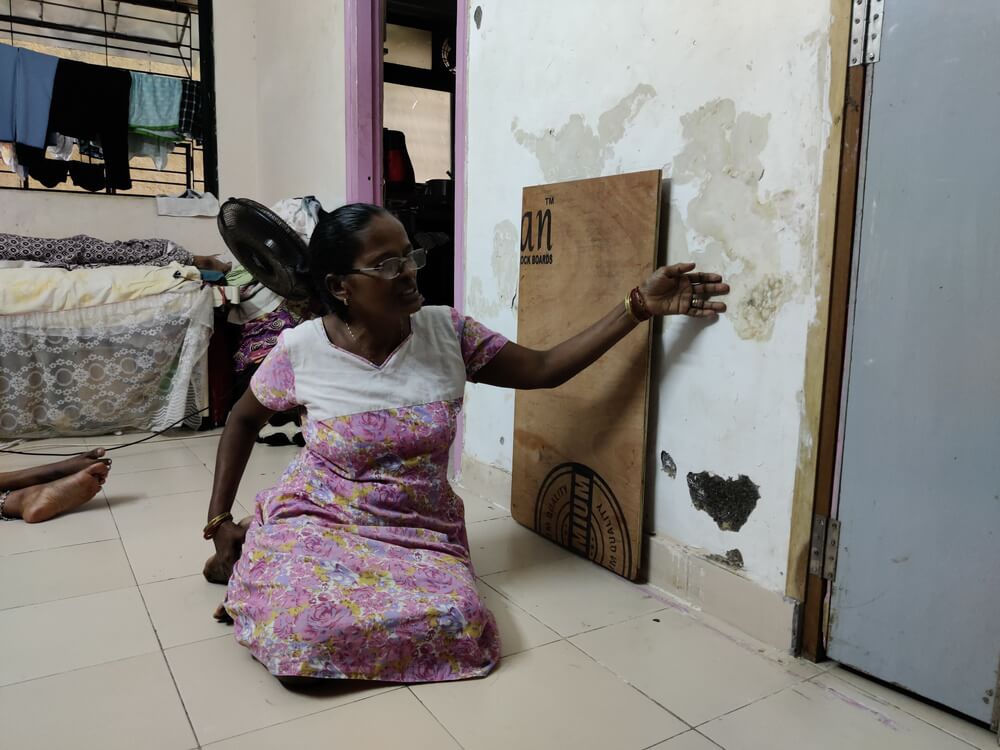
Several studies have pointed out that though the SRA buildings appear to be apartment-like buildings they have retained the qualities of informal housing, earning them the sobriquet of “vertical slums”. Besides, as this study[5] pointed out, the in-situ development with Floor Space Index relaxations of up to 4 for SRA projects puts undue “pressure on civic infrastructure and services, which have not seen any proportionate expansion or improvement”. Residents, reporting privacy concerns, had installed permanent window covering which also obstructed the little air and daylight reaching their homes.[6]
Lack of space has also been a concern. Maria D’Souza, 47, who ran a general store in Shroffwadi said, “Earlier, people somehow made space for themselves by building additional structures, but we have to adjust within what is provided here.” Neighbours often clash over using the corridors in SRA buildings as storage spaces, corridors are also used by children as play areas, annoying others, walls and ceilings show leakages and residents fear that the structures are getting weaker every monsoon when plastic buckets are placed at places in homes and corridors to collect the dripping water.
In Ambedkar Nagar, some resettled slum dwellers still await their documents. Shashikant Kamble, driver and driving instructor, claims that he does not have papers to his flat and has filed a court case, but his everyday worry is about the lift in his building whose doors jerk open or shut and the generator which is not in working condition. Kamble also recounted that “the society used corpus funds to install CCTV network but when a cycle was stolen, people found that the cameras were not in working condition”.
The SRA building design has also isolated families and disrupted social networks, residents said. The design, which is usually long corridors with tenements opening on either side, discourage interpersonal interactions. As Gracy Fernandez said, “Since we moved here, everybody has become isolated from each other behind their closed doors. It doesn’t feel like a community anymore.” In Golibar, residents believe that the structures could come crashing down in incessant rain. “No ambulance, fire brigade, or rescue team can get inside here,” pointed out Mohammed Iqbal Bhai, who lives in an inner building and runs a small plumbing shop.
Alternative to SRA model
Even as the SRA model became the default way to rehouse slum dwellers in Mumbai, there were alternatives by housing rights organisations to move slum dwellers into more hospitable settings with secure tenurial rights. Sangharsh Nagar in Powai was one such attempt and could have been adopted by governments.
Slum dwellers who had built homes abutting the Sanjay Gandhi National Park (SGNP) like Anita Jadhav, 55, moved to Sangharsh Nagar in 2007. Jadhav and others were relieved to finally have legally sanctioned roofs over their heads; they carry terrible memories of demolitions near SGNP: “There was constant turmoil, politicians would invite slum residents to meetings to discuss the situation where they were given biscuit packets worth Rs 2 and water, and while people were at these meetings, authorities would destroy our homes.”
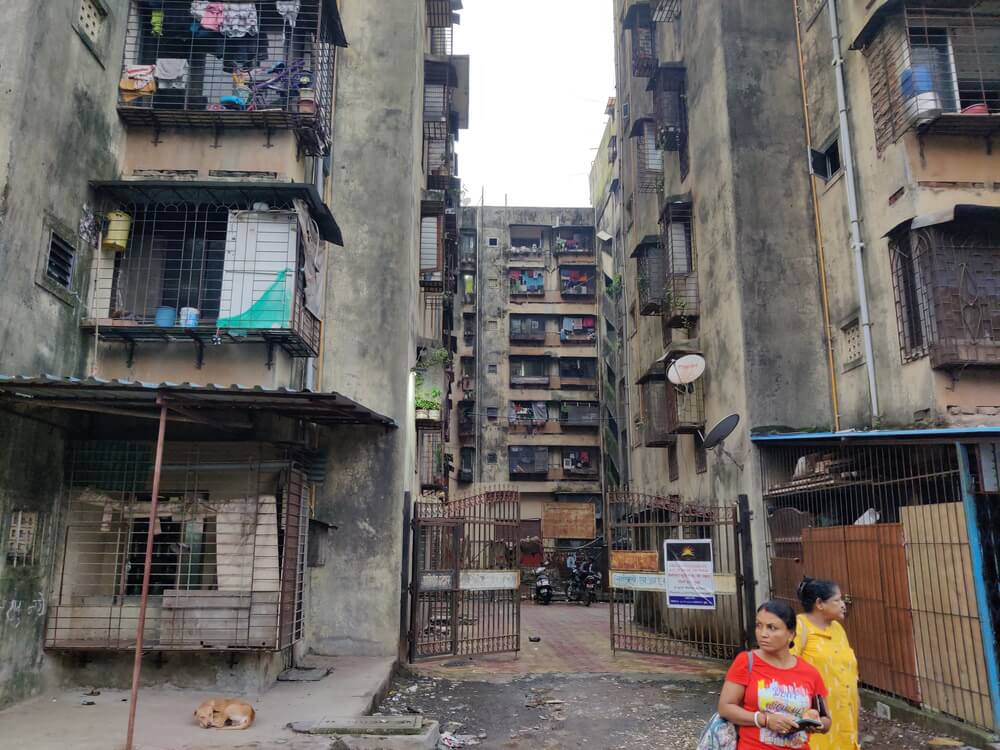
After pitched battles on site and in court, slum residents organised themselves with the support of the housing rights group Nivara Hakk Sangharsh Samiti and got a plot allotted by the government. Here, what once used to be a quarry, they were able to construct a township with wide roads, open spaces, courtyards for a set of buildings, and tenurial security to their homes as well as the land on which their buildings stood.
Sangharsh Nagar gave them job opportunities, a primary school, water supply on tap, and electricity connections. However, parts of this area were turned over to a real estate developer who constructed SRA-type buildings. “The township was planned with open spaces and community spaces, now we don’t even have a market or street lights,” said Jadhav.
A “slum free” Mumbai is what the SRA declared in 1995-97 explaining its vision.[7] In its working though, the SRA model has neither “rehabilitated” the majority of Mumbai’s slum dwellers nor provided decent housing to those it terms as its beneficiaries. Perhaps, “slum free” is a myth sold to millions in the city while enabling private builders, some fly-by-night who started a project only to abandon it, to rake in profits.
Jashvitha Dhagey developed a deep interest in the way cities function, watching Mumbai at work. She holds a post-graduate diploma in Social Communications Media from Sophia Polytechnic. She loves to watch and chronicle the multiple interactions between people, between people and power, and society and media.
Photos by Jashvitha Dhagey

